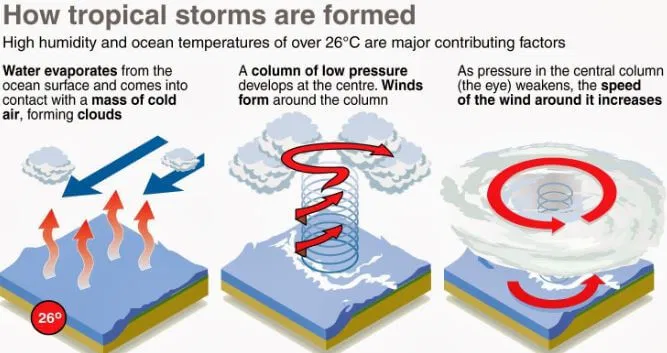- Filter By :
- Geography
- History
- Indian Heritage & Culture
- Indian Society
-
Q. Tropical cyclones are products of complex interactions between oceanic and atmospheric systems. Discuss the factors responsible for their formation and regional distribution, with special reference to the Indian Ocean region. (250 words)
02 Jun, 2025 GS Paper 1 GeographyApproach:
- Define tropical cyclones and explain their basic characteristics.
- Discuss the oceanic and atmospheric conditions necessary for their formation and explain why cyclones form predominantly in certain regions, focusing on the Indian Ocean.
- Conclude suitably.
Introduction:
Tropical cyclones are intense low-pressure systems characterized by strong winds and heavy rainfall, resulting from complex interactions between oceanic and atmospheric conditions. These cyclones are significant because of their devastating impact on coastal populations, especially in the Indian Ocean region, which is prone to frequent and sometimes highly destructive cyclones.
Body:
Key Factors Responsible for Tropical Cyclone Formation:
Oceanic Factor:
- Sea Surface Temperature (SST): Tropical cyclones require sea surface temperatures above 27°C to supply the necessary moisture and latent heat that drive convection and sustain storm development.
- In the Indian Ocean, this condition is typically met during the pre-monsoon (April–June) and post-monsoon (October–December) seasons, making these periods prone to cyclogenesis.
Atmospheric Factors:
- Atmospheric Instability: Atmospheric instability enhances vertical air movement, where warm, moist air near the ocean surface rises rapidly through cooler air above, triggering convection and thunderstorm activity.
- This convective process is essential for the formation and intensification of tropical cyclones.
- Coriolis Force: The Earth’s rotation causes the deflection of winds, creating a cyclonic vortex. Cyclones cannot form near the equator (within 5° latitude) due to insufficient Coriolis force. Most cyclones form between 10° and 20° latitudes.
- Low Vertical Wind Shear: Wind shear refers to the change in wind speed or direction with height. Low vertical wind shear allows the cyclone’s structure to remain intact and intensify.
- High wind shear can disrupt cyclone formation by displacing the storm’s convection.
- Pre-existing Low-Pressure Disturbance: Tropical cyclones typically originate from pre-existing low-pressure systems, such as easterly waves, troughs, or depressions.
- These disturbances often occur within the ITCZ, a region near the equator where northeast and southeast trade winds converge, causing rising air and persistent convection.
- Upper Atmospheric Divergence: A well-developed divergence aloft allows rising air to evacuate the storm efficiently, sustaining low pressure at the center.
Regional Distribution & Unique Features of Cyclones in the Indian Ocean:
- The Indian Ocean sees cyclones mainly in two regions-the Bay of Bengal and the Arabian Sea (less frequent but sometimes very severe).
- Cyclones in the Bay of Bengal are generally more frequent and intense than those in the Arabian Sea due to higher sea surface temperatures and favorable atmospheric conditions.
- The Bay of Bengal’s warm waters and funnel-shaped coastline exacerbate storm surges, causing significant flooding and damage in countries like India, Bangladesh, and Myanmar.
- The Arabian Sea cyclones are less frequent but can be intense, often affecting western India, Oman, and Yemen.
- The Indian Ocean region’s cyclonic activity is also influenced by phenomena such as the Indian Ocean Dipole (IOD) and El Niño-Southern Oscillation (ENSO), which modulate sea surface temperatures and atmospheric circulation patterns.
Conclusion:
Tropical cyclones are complex natural phenomena shaped by oceanic heat, and atmospheric patterns. Their regional distribution, especially in the Indian Ocean, is governed by sea surface temperatures, wind currents, and atmospheric conditions. Understanding these factors is vital for predicting cyclones and minimizing their devastating impact through effective monitoring and early warning systems.
To get PDF version, Please click on "Print PDF" button.
Print PDF






